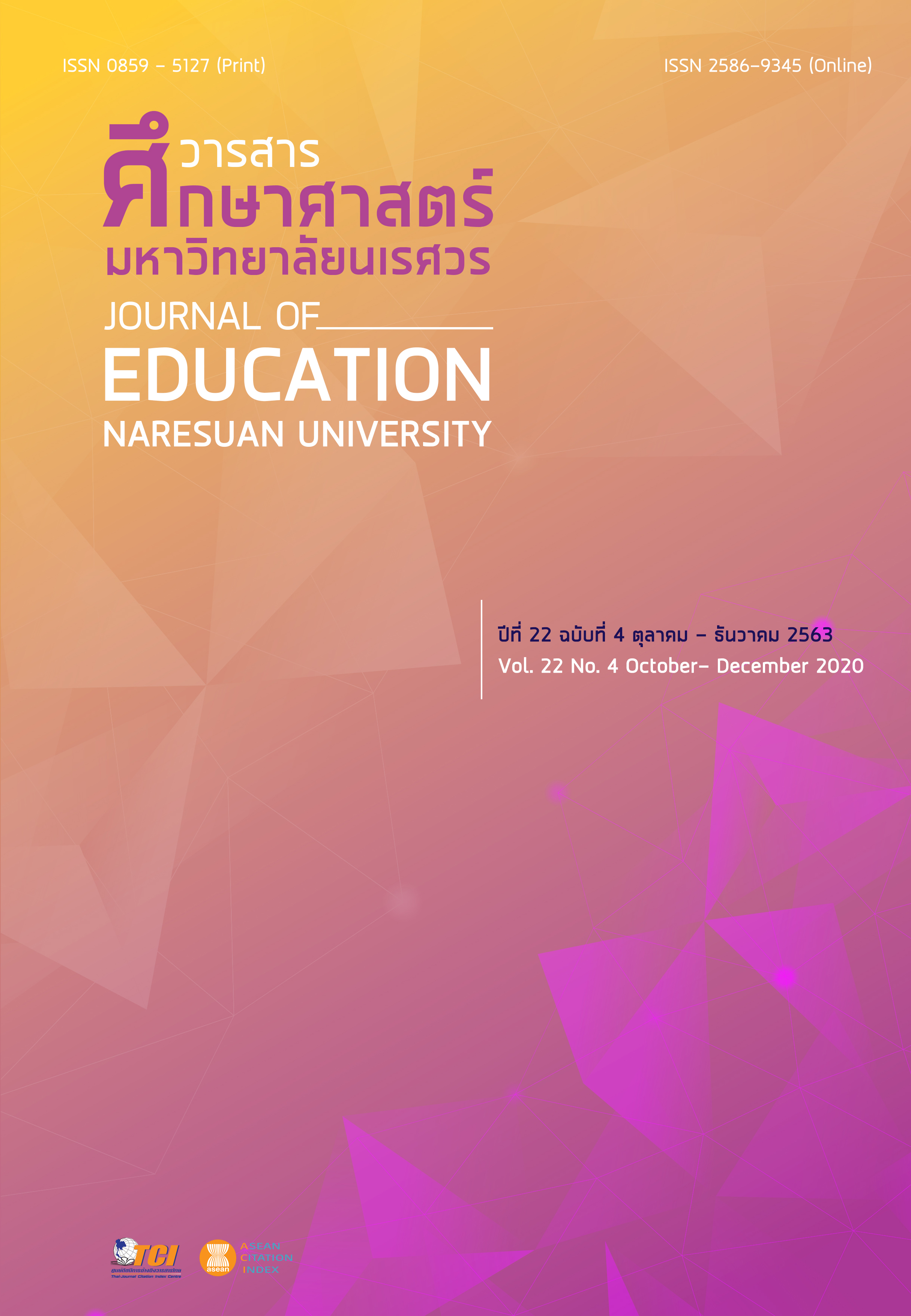AN INSTRUCTIONAL MODEL DEVELOPMENT BASED ON AUTHENTIC LEARNING AND COMMUNICATIVE LEARNING APPROACHES TO ENHANCE VOCATIONAL BACHELOR’S DEGREE STUDENTS’ ENGLISH-SPEAKING ABILITY FOR PROJECT PRESENTATION IN THE NORTHERN REGION OF THAILAND
Main Article Content
Abstract
The objectives of this study were to 1) develop and assess the quality of the developed instructional model, 2) implement the developed instructional model and study the results of an instructional model implementation on students’ English-speaking ability for project presentation, and 3) study learners’ satisfaction towards the instructional model and implementation process. The instructional model was designed following 3 research and development steps. The instructional model was implemented with two different groups of 25 and 23 students respectively selected by clustered random sampling. Data were analyzed using scoring rubrics, descriptive statistics, T-test dependable, and content analysis. The results revealed as follows: 1) the developed instructional model consisted of 5 components: principle, objective, learning content, learning instruction and evaluation. The developed instructional model was at the highest level of appropriateness ( = 4.54). An English-speaking learning instruction was designed with 5 steps: presentation and explanation to subject matter, task assignment, re-definition of tasks and inquiry, practice and accomplishment of speaking task and presentation of speaking task, 2) students’ English-speaking ability for project presentation for both groups was significantly higher than before at 0.01 level, and 3) learners’ satisfaction towards an instructional model implementation process was at a high level (
= 4.42) and students expressed positive views towards instructional model and instructional model implementation process.
Article Details
The owner of the article does not copy or violate any of its copyright. If any copyright infringement occurs or prosecution, in any case, the Editorial Board is not involved in all the rights to the owner of the article to be performed.
References
Allwright, R. (1979). Language learning through communication practice. In Brumfit, C. J. and Johnson, K. (eds.) The Communicative Approach to Language Teaching. Oxford: Oxford University Press.
Brown, D. (2007). Teaching by principles: An interactive approach to language pedagogy. Englewood Cliffs, NJ: Prentice-Hall Regents.
Brown, H. D. (1994). Teaching by principles: An interactive approach to language pedagogy. Prentice Hall, Englewood Cliffs.
Burns, A., & Joyce, H. (1997). Focus on speaking. Sydney: National Centre for English Language Teaching and Research.
Cambell, R. N. (1972). Linguistic and social aspects of communicative competence in teaching English as a second foreign language. Massachusetts: Newbury House Publishers.
Carter, R., & Nunan, D. (2001). The Cambridge guide to teaching English to speakers of other languages. Cambridge University Press.
Collins, J. (1988). Language and class in minority education. Anthropology & Education Quarterly, 19(4), 299–326. 10.1525/aeq.1988.19.4.05x0914d
Donovan, S. M., Bransford, J. D., & Pellegrino, J. W. (1999). How people learn: Bridging research and practice. Washington, DC: The National Academies Press. https://doi.org/10.17226/9457.
Harmer, J. (2001). The practice of English language teaching (3rd ed.). London and New York: Longman Group.
Henry, Y. A. (2019). A development of an instructional model based on collaborative and communicative learning approaches to enhance lower secondary students’ English-speaking skills in Thailand (Doctoral dissertation). Phitsanulok: Naresuan University.
Hymes, D. (1972). On communicative competence. In J. B. Pride & J. Holmes (Eds.), Sociolinguistics (pp. 269–293). London: Penguin.
Joyce, B., & Weil, M. (2009). Models of teaching (8th ed.). Boston: Allyn and Bacon.
Kaewurai, W. (2011). Developing a learning facilitation model for the development of quality learners on ethic, intellect, and learning. Graduate School Journal of Nakornsawan Rajabhat University, 6(15), 11-30.
Kethongkum, W. (2005). The effects of using English supplementary materials on developing listening and speaking competence of the third-year vocational level students in tourism and hotel section at Premruetai Administration Technology School (Master thesis). Bangkok: Srinakharinwirot University.
Khemkhien, A. (2010). Teaching English speaking and English Test in the Thai context: A reflection from Thai perspective (Electronic version). English Language Teaching, 3, 184-190.
Littlewood, W. (1998). Communicative activities. Cambridge University Press.
Littlewood, W. (2002). Communicative language teaching: An introduction. Cambridge: Cambridge University Press.
Lombardi, M. M. (2007). Authentic learning for the 21st century: An overview. Educause learning initiative paper 1. Retrieved from http://www.educause.edu/ir/library/pdf/ELI3009.pdf
Ministry of Education. (2008). The Basic Education Curriculum B.E. 2551 (A. D. 2008). Bangkok: Kurusapa Ladprao Publishing.
Mongkonwanich, C. (2009). Wise model of competitive workplace. Retrieved October 5, 2010, from http:/www.siamtech.ac.th/wase/wise.doc
Newman et al. (1996). Authentic achievement: Restructuring schools for intellectual quality. San Francisco: Jossey-Bass.
Nunan, D. (1991). Language teaching methodology: A textbook for teacher. Upper Saddle River, NJ: Prentice Hall.
Office of Non-Formal and Informal Education. (2011). ASEAN. Retrieved June 14, 2011, from
http://www.nfe.go.th/en/index.php?option=com_content&view=article&id=4&Itemid=21
Office of Vocational Education Commission (2010). The high certificate vocational Curriculum. Retrieved June 17, 2011, from http://bsq.vec.go.th/course/data_new300.pdf
Piaget, J. (1986). Essay on necessity. Human Development, 29(6), 301–314. https://doi.org/10.1159/000273106
Phuphanpet, U. (2004). The effects of using oral communication activities to develop English speaking ability for the first-year certificate vocational students (Master thesis). Bangkok: Srinakharinwirot University.
Preedekun, A., Mejang, A., Ngaorungsi, K., & Kaewurai, W. (2010). The development of a listening and speaking English skills instructional model based on communicative approach and brain-based learning principles to enhance communicative competence of Rajabhat University students. Journal of Education Naresuan University, 13(Special Edition), 154-175.
Promshoit, V. (2010). The use of English language activities in developing listening and speaking ability of second year vocational students majoring in Hotel Management in Samutprakarn Institute of Commerce and Technology School (Master thesis). Bangkok: Srinakharinwirot University.
Richards, J. C. (2006). Communicative language teaching today. New York: Cambridge University Press.
Richards, J. C., & Rodgers, T. S. (2014). Approaches and methods in language teaching (3rd ed.). Cambridge: Cambridge University Press.
Savignon, S. J. (1991). Communicative language teaching state of the art. TESOL Quarterly, 25, 261-275.
Soares, K. (2010). Why learn English as a second language? Retrieved June 16, 2011, from
http://www.articlesbase.com/languages-articles/why-learn-english-as-a-second-language-4911750.html
Thornbury, S. (2005). How to teach speaking. Essex: Pearson/Longman.
Wongsuriya, P. (2003). The development of English speaking and listening competence through real life situations: A study of first-year higher certificate Vocational students at Rajamangala Institute of Technology Sakonnakorn Campus (Master thesis). Bangkok: Srinakharinwirot University.


